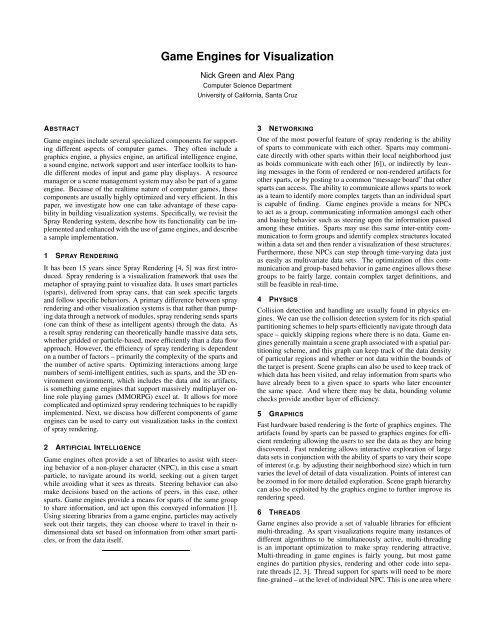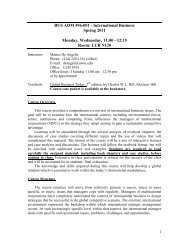Game Engines for Visualization - The Study Stream
Game Engines for Visualization - The Study Stream
Game Engines for Visualization - The Study Stream
Create successful ePaper yourself
Turn your PDF publications into a flip-book with our unique Google optimized e-Paper software.
<strong>Game</strong> <strong>Engines</strong> <strong>for</strong> <strong>Visualization</strong><br />
Nick Green and Alex Pang<br />
Computer Science Department<br />
University of Cali<strong>for</strong>nia, Santa Cruz<br />
ABSTRACT<br />
<strong>Game</strong> engines include several specialized components <strong>for</strong> supporting<br />
different aspects of computer games. <strong>The</strong>y often include a<br />
graphics engine, a physics engine, an artifical intelligence engine,<br />
a sound engine, network support and user interface toolkits to handle<br />
different modes of input and game play displays. A resource<br />
manager or a scene management system may also be part of a game<br />
engine. Because of the realtime nature of computer games, these<br />
components are usually highly optimized and very efficient. In this<br />
paper, we investigate how one can take advantage of these capability<br />
in building visualization systems. Specifically, we revisit the<br />
Spray Rendering system, describe how its functionality can be implemented<br />
and enhanced with the use of game engines, and describe<br />
a sample implementation.<br />
1 SPRAY RENDERING<br />
It has been 15 years since Spray Rendering [4, 5] was first introduced.<br />
Spray rendering is a visualization framework that uses the<br />
metaphor of spraying paint to visualize data. It uses smart particles<br />
(sparts), delivered from spray cans, that can seek specific targets<br />
and follow specific behaviors. A primary difference between spray<br />
rendering and other visualization systems is that rather than pumping<br />
data through a network of modules, spray rendering sends sparts<br />
(one can think of these as intelligent agents) through the data. As<br />
a result spray rendering can theoretically handle massive data sets,<br />
whether gridded or particle-based, more efficiently than a data flow<br />
approach. However, the efficiency of spray rendering is dependent<br />
on a number of factors – primarily the complexity of the sparts and<br />
the number of active sparts. Optimizing interactions among large<br />
numbers of semi-intelligent entities, such as sparts, and the 3D environment<br />
environment, which includes the data and its artifacts,<br />
is something game engines that support massively multiplayer online<br />
role playing games (MMORPG) excel at. It allows <strong>for</strong> more<br />
complicated and optimized spray rendering techniques to be rapidly<br />
implemented. Next, we discuss how different components of game<br />
engines can be used to carry out visualization tasks in the context<br />
of spray rendering.<br />
2 ARTIFICIAL INTELLIGENCE<br />
<strong>Game</strong> engines often provide a set of libraries to assist with steering<br />
behavior of a non-player character (NPC), in this case a smart<br />
particle, to navigate around its world, seeking out a given target<br />
while avoiding what it sees as threats. Steering behavior can also<br />
make decisions based on the actions of peers, in this case, other<br />
sparts. <strong>Game</strong> engines provide a means <strong>for</strong> sparts of the same group<br />
to share in<strong>for</strong>mation, and act upon this conveyed in<strong>for</strong>mation [1].<br />
Using steering libraries from a game engine, particles may actively<br />
seek out their targets, they can choose where to travel in their n-<br />
dimensional data set based on in<strong>for</strong>mation from other smart particles,<br />
or from the data itself.<br />
3 NETWORKING<br />
One of the most powerful feature of spray rendering is the ability<br />
of sparts to communicate with each other. Sparts may communicate<br />
directly with other sparts within their local neighborhood just<br />
as boids communicate with each other [6]), or indirectly by leaving<br />
messages in the <strong>for</strong>m of rendered or non-rendered artifacts <strong>for</strong><br />
other sparts, or by posting to a common “message board” that other<br />
sparts can access. <strong>The</strong> ability to communicate allows sparts to work<br />
as a team to identify more complex targets than an individual spart<br />
is capable of finding. <strong>Game</strong> engines provide a means <strong>for</strong> NPCs<br />
to act as a group, communicating in<strong>for</strong>mation amongst each other<br />
and basing behavior such as steering upon the in<strong>for</strong>mation passed<br />
among these entities. Sparts may use this same inter-entity communication<br />
to <strong>for</strong>m groups and identify complex structures located<br />
within a data set and then render a visualization of these structures.<br />
Furthermore, these NPCs can step through time-varying data just<br />
as easily as multivariate data sets. <strong>The</strong> optimization of this communication<br />
and group-based behavior in game engines allows these<br />
groups to be fairly large, contain complex target definitions, and<br />
still be feasible in real-time.<br />
4 PHYSICS<br />
Collision detection and handling are usually found in physics engines.<br />
We can use the collision detection system <strong>for</strong> its rich spatial<br />
partitioning schemes to help sparts efficiently navigate through data<br />
space – quickly skipping regions where there is no data. <strong>Game</strong> engines<br />
generally maintain a scene graph associated with a spatial partitioning<br />
scheme, and this graph can keep track of the data density<br />
of particular regions and whether or not data within the bounds of<br />
the target is present. Scene graphs can also be used to keep track of<br />
which data has been visited, and relay in<strong>for</strong>mation from sparts who<br />
have already been to a given space to sparts who later encounter<br />
the same space. And where there may be data, bounding volume<br />
checks provide another layer of efficiency.<br />
5 GRAPHICS<br />
Fast hardware based rendering is the <strong>for</strong>te of graphics engines. <strong>The</strong><br />
artifacts found by sparts can be passed to graphics engines <strong>for</strong> efficient<br />
rendering allowing the users to see the data as they are being<br />
discovered. Fast rendering allows interactive exploration of large<br />
data sets in conjunction with the ability of sparts to vary their scope<br />
of interest (e.g. by adjusting their neighborhood size) which in turn<br />
varies the level of detail of data visualization. Points of interest can<br />
be zoomed in <strong>for</strong> more detailed exploration. Scene graph hierarchy<br />
can also be exploited by the graphics engine to further improve its<br />
rendering speed.<br />
6 THREADS<br />
<strong>Game</strong> engines also provide a set of valuable libraries <strong>for</strong> efficient<br />
multi-threading. As spart visualizations require many instances of<br />
different algorithms to be simultaneously active, multi-threading<br />
is an important optimization to make spray rendering attractive.<br />
Multi-threading in game engines is fairly young, but most game<br />
engines do partition physics, rendering and other code into separate<br />
threads [2, 3]. Thread support <strong>for</strong> sparts will need to be more<br />
fine-grained – at the level of individual NPC. This is one area where
spray rendering will need to drive further development of support<br />
and management of large number of threads.<br />
7 SOUND<br />
<strong>The</strong> goal of understanding and gaining insight from data sets is not<br />
restricted to mapping data to visual channels. Sonification have<br />
been found to be effective in communicating in<strong>for</strong>mation as well.<br />
Sound in games adds realism and reflects the mood of the game.<br />
This is supported by sound engines that can dynamically adjust<br />
playback parameters, be triggered by proximity sensors, etc. <strong>The</strong>se<br />
capabilities can also be used to map data to sound. <strong>The</strong> combination<br />
of scene graphs and audio engines allow sound clips to have<br />
fairly advanced behaviors. For example, an audio clip could only<br />
be triggered if the conjunction of the output of two sparts produce<br />
a positive outcome. Allowing such complex behaviors would help<br />
preserve the significance and meaning of sound and keep it from<br />
over-use. 3D positional sounds e.g. OpenAL, can allow users to<br />
know when one or more of his sparts have found an important piece<br />
of data and intuitively localize where the data was found.<br />
8 GUI<br />
User interfaces <strong>for</strong> playing games must be intuitive whether it is<br />
controlling a first person shooter (FPS) game or directing an entire<br />
army. <strong>The</strong> metaphor of using cans of spray paint is ideal <strong>for</strong> an<br />
FPS type interface. In our sample application described below, the<br />
user’s ability to shoot sparts from the camera’s viewpoint was implemented<br />
with basic a GUI API. <strong>Game</strong> engines provide efficient<br />
yet simple to use features such as firing and switching weapons i.e.<br />
spray cans and hence type of sparts being fired.<br />
9 SAMPLE IMPLEMENTATION<br />
We have some initial results of implementing this idea using Open-<br />
Steer (http://opensteer.source<strong>for</strong>ge.net/) as the game engine.<br />
<strong>The</strong> primary strength of OpenSteer is in controlling crowd behavior<br />
– which corresponds to the primary task of controlling the behavior<br />
of sparts. We describe how some spray rendering visualization<br />
techniques can be realized using OpenSteer.<br />
9.1 Isosurface Rendering<br />
In this visualization, the user chooses the target (scalar threshold)<br />
that the sparts are searching <strong>for</strong>. Upon finding their target, the sparts<br />
render a small polygon that is oriented on a plane perpendicular to<br />
the gradient of the data at that point, centered at that point. <strong>The</strong><br />
color of the polygon can be mapped to the scalar magnitude at<br />
that point. Alternatively, the red, green, blue components can be<br />
mapped to the components of the gradient.<br />
9.2 <strong>Stream</strong>line Rendering<br />
In this visualization, sparts will set their trajectories to that of the<br />
data they have encountered. Each spart will proceed to travel along<br />
the trajectory of the data at its current location. As each spart travels,<br />
it will leave behind a polyline to indicate its path. A target may<br />
also be associated with each spart e.g. velocity magnitude, which<br />
can be used to control the generation of a streamline. For example,<br />
if the velocity magnitude has fallen below a specified threshold, the<br />
streamline may be terminated.<br />
9.3 Explosive Tracing<br />
Typically, an FPS interface is used to deliver the sparts into the<br />
data space. An alternative is to allow sparts to spawn themselves.<br />
As be<strong>for</strong>e, the spart are fired towards the data until it finds its target.<br />
It then analyzes its six immediate neighborhoods and <strong>for</strong> each<br />
of the adjacent points that also satisfies its target conditions, this<br />
spart spawns another spart traveling towards that direction. Positions<br />
that have been visited are marked. This procedure is applied<br />
Figure 1: Image shows results using two types of sparts. Isosurface<br />
sparts render the low-magnitude portions of the data, while streamline<br />
sparts show the flow pattern.<br />
recursively. For sparts that find streamlines, spawned sparts traveling<br />
within valid data also leave behind a color mapped line.<br />
Figure 2: This visualization starts from one spart that recursively<br />
sends sparts to adjacent spaces where target data is found. Each<br />
new spart renders a small segment of a streamline. All data matching<br />
the original sparts target, and reachable from the first target data<br />
found is discovered. <strong>The</strong> gray area visible on some edges are many<br />
sparts, still finding target data and spawning new sparts.<br />
10 CONCLUSION<br />
We are interested to find out how one can take advantage of game<br />
engines to per<strong>for</strong>m visualization. <strong>The</strong> different components of a<br />
game engine i.e. AI, physics, graphics, networking, sound, etc. can<br />
be readily mapped to the Spray Rendering paradigm. Our initial investigation<br />
uses the OpenSteer game engine. Results are promising,<br />
and we plan to incorporate other game engine functionality such as<br />
networking and physics.<br />
REFERENCES<br />
[1] Valve. http://source.valvesoftware.com/SourceBrochure.pdf, 2008.<br />
[2] R. Chabukswar, A. Lake, and M. Lee. Multi-threaded rendering and<br />
physics simulation. Technical report, Intel, 2005.<br />
[3] H. Gabb and A. Lake. Threading in 3D game engine basics.<br />
www.gamasutra.com/features/20051117/gabb 01.shtml, 2005.<br />
[4] A. Pang and N. Alper. Mix & Match: A construction kit <strong>for</strong> visualization.<br />
In Proceedings: <strong>Visualization</strong> ’94, pages 302–309. IEEE Computer<br />
Society, 1994.<br />
[5] A. Pang and C. M. Wittenbrink. Collaborative 3D visualization with<br />
CSpray. IEEE Computer Graphics and Applications, pages 32–41,<br />
March 1997. Special issue on: 3D and Multimedia on the In<strong>for</strong>mation<br />
Superhighway.<br />
[6] C. W. Reynolds. Flocks, herds and schools: A distributed behavioral<br />
model. Computer Graphics, 21(4):25–34, 1987.












